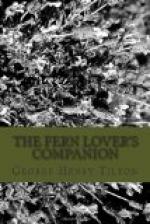[Illustration: Aspidium cristatum X marginale One of the very best for cultivation]
(5) BOOTT’S SHIELD FERN
Aspidium Boottii. THELYPTERIS BOOTTII
Dryopteris Boottii. Nephrodium Boottii
Fronds one to three feet high, oblong-lanceolate, bipinnate, the upper pinnae lanceolate, the lower triangular with spinulose teeth. Sori in rows each side of the midvein, one to each tooth and often scattering on the lower pinules. Indusium large, minutely glandular, variable.
This fern has been thought to be a hybrid between the crested and spinulose ferns, but is now regarded as distinct. Like the crested fern its fertile fronds wither in autumn, while its sterile blades remain green throughout the winter. It differs from it, however, by being twice pinnate below, and from the typical spinulose fern by its glandular indusium; but from the intermediate variety it is more difficult to separate it, as that also has indusiate glands. The collector needs to study authentic specimens and have in mind the type, with its rather long, narrow blade as an aid to the verbal description, and even then he will often find it an interesting puzzle. Shaded swamps throughout our area.
[Illustration: Aspidium Boottii]
(6) SPINULOSE SHIELD FERN
Aspidium spinulosum. THELYPTERIS SPINULOSA
Dryopteris spinulosa. Nephrodium spinulosum_
Stipes with a few pale brown deciduous scales. Fronds one to two and one-half feet long, ovate-lanceolate, twice pinnate. Pinnae oblique to the rachis, the lower ones broadly triangular, the upper ones elongated. Pinnules on the inferior side of the pinnae often elongated, especially the lower pair, the pinnule nearest the rachis being usually the longest, at least in the lowest pinnae. Pinnules variously cut into spinulose-toothed segments. Indusium smooth, without marginal glands.
The common European type, but in this country far less common than its varieties. They all prefer rich, damp woods, and because of their graceful outline and spiny-toothed lobes are very attractive. They can be transplanted without great difficulty, and the fern garden depends upon them for its most effective lacework.
Var. intermedium has the scales of the stipe brown with darker center. Fronds ovate-oblong, often tripinnate. Pinnae spreading, oblong-lanceolate. Pinnules pinnately cleft, the oblong lobes spinulose-toothed at the apex. Margin of the indusium denticulate and beset with minute, stalked glands. In woods nearly everywhere—our most common form. Millions of fronds of this variety are gathered in our northern woods, placed in cold storage and sent to florists to be used in decorations.[A] As long as the roots are not disturbed the crop is renewed from year to year, and no great harm seems to result. Canada to Kentucky and westward.
[Footnote A: Horticulture reports that twenty-eight million fern leaves have been shipped from Bennington, Vt., in a single season; and that nearly $100,000 were paid out in wages.]




